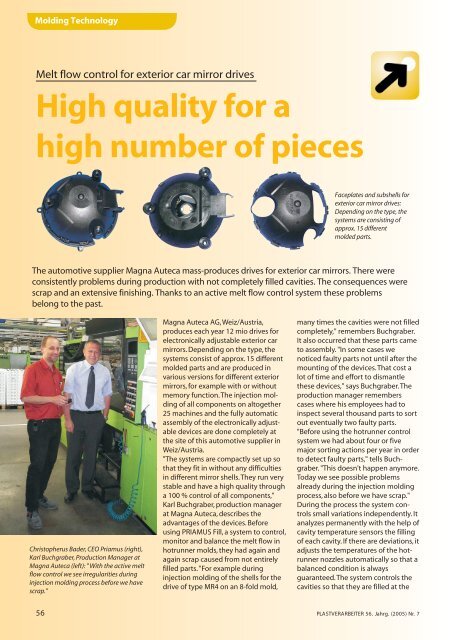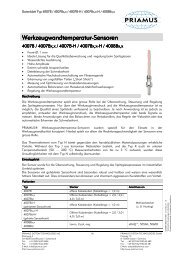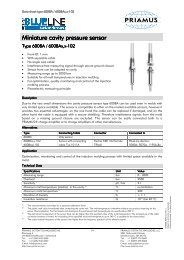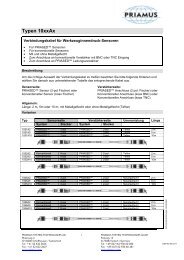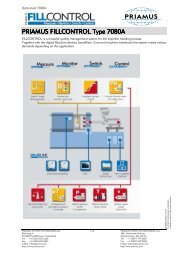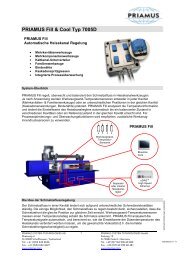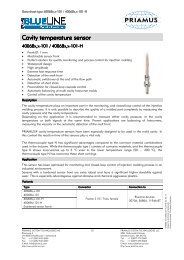You also want an ePaper? Increase the reach of your titles
YUMPU automatically turns print PDFs into web optimized ePapers that Google loves.
Molding Technology<br />
<strong>Melt</strong> <strong>flow</strong> <strong>control</strong> for exterior car mirror drives<br />
High quality for a<br />
high number of pieces<br />
Faceplates and subshells for<br />
exterior car mirror drives:<br />
Depending on the type, the<br />
systems are consisting of<br />
approx. 15 different<br />
molded parts.<br />
The automotive supplier Magna Auteca mass-produces drives for exterior car mirrors. There were<br />
consistently problems during production with not completely filled cavities. The consequences were<br />
scrap and an extensive finishing. Thanks to an active melt <strong>flow</strong> <strong>control</strong> system these problems<br />
belong to the past.<br />
Christopherus Bader, CEO Priamus (right),<br />
Karl Buchgraber, Production Manager at<br />
Magna Auteca (left): " With the active melt<br />
<strong>flow</strong> <strong>control</strong> we see irregularities during<br />
injection molding process before we have<br />
scrap."<br />
Magna Auteca AG, Weiz/Austria,<br />
produces each year 12 mio drives for<br />
electronically adjustable exterior car<br />
mirrors. Depending on the type, the<br />
systems consist of approx. 15 different<br />
molded parts and are produced in<br />
various versions for different exterior<br />
mirrors, for example with or without<br />
memory function. The injection molding<br />
of all components on altogether<br />
25 machines and the fully automatic<br />
assembly of the electronically adjustable<br />
devices are done completely at<br />
the site of this automotive supplier in<br />
Weiz/Austria.<br />
"The systems are compactly set up so<br />
that they fit in without any difficulties<br />
in different mirror shells. They run very<br />
stable and have a high quality through<br />
a 100 % <strong>control</strong> of all components,"<br />
Karl Buchgraber, production manager<br />
at Magna Auteca, describes the<br />
advantages of the devices. Before<br />
using PRIAMUS Fill, a system to <strong>control</strong>,<br />
monitor and balance the melt <strong>flow</strong> in<br />
hotrunner molds, they had again and<br />
again scrap caused from not entirely<br />
filled parts. "For example during<br />
injection molding of the shells for the<br />
drive of type MR4 on an 8-fold mold,<br />
many times the cavities were not filled<br />
completely," remembers Buchgraber.<br />
It also occurred that these parts came<br />
to assembly. "In some cases we<br />
noticed faulty parts not until after the<br />
mounting of the devices. That cost a<br />
lot of time and effort to dismantle<br />
these devices," says Buchgraber. The<br />
production manager remembers<br />
cases where his employees had to<br />
inspect several thousand parts to sort<br />
out eventually two faulty parts.<br />
"Before using the hotrunner <strong>control</strong><br />
system we had about four or five<br />
major sorting actions per year in order<br />
to detect faulty parts," tells Buchgraber.<br />
"This doesn't happen anymore.<br />
Today we see possible problems<br />
already during the injection molding<br />
process, also before we have scrap."<br />
During the process the system <strong>control</strong>s<br />
small variations independently. It<br />
analyzes permanently with the help of<br />
cavity temperature sensors the filling<br />
of each cavity. If there are deviations, it<br />
adjusts the temperatures of the hotrunner<br />
nozzles automatically so that a<br />
balanced condition is always<br />
guaranteed. The system <strong>control</strong>s the<br />
cavities so that they are filled at the<br />
56 PLASTVERARBEITER 56. Jahrg. (2005) Nr. 7
the same and in the time. With a free<br />
definable temperature window the<br />
limits can be set within the hotrunner<br />
temperature has to range until an<br />
error message arises. "By monitoring<br />
the mold cavity temperature not only<br />
problems with hotrunners can be<br />
seen but also such with temperature<br />
<strong>control</strong>lers or blocked cooling<br />
channels," knows Buchgraber. "Users<br />
can save quality <strong>control</strong> costs because<br />
if there are no faulty injection molded<br />
parts there is no need to <strong>control</strong><br />
them. "<br />
Detect error causes<br />
During production of the subshell for<br />
an electronically adjustable drive the<br />
<strong>control</strong> system identified for example<br />
irregularities caused by the hotrunner.<br />
"We knew from filling studies that the<br />
single cavities had different fillings,"<br />
remembers Buchgraber. "After<br />
installing the <strong>control</strong> system we saw<br />
clearly that the temperature<br />
differences during the filling of each<br />
cavitiy were caused by an insufficient<br />
feeding of the heating. So it was the<br />
hotrunner's manufacturer<br />
responsibility to make adequate<br />
corrections. In addition, the system<br />
recognized deviations in viscosity of<br />
the raw material. We then asked the<br />
supplier to deliver a more constant<br />
quality."<br />
"In general the technology of active<br />
melt <strong>flow</strong> <strong>control</strong> ensures a high<br />
transparency of the whole injection<br />
M agna Auteca<br />
Magna Autece AG, Weiz/Austria, produces<br />
with 280 employees electronically<br />
adjustable plastic drives for exterior<br />
car mirrors. Clients are automotive<br />
manufacturer such as Daimler-<br />
Chrysler, VW, Audi, General Motors<br />
and BMW. The 1987 established company<br />
is a daughter of the worldwide<br />
operating automotive supplier Magna.<br />
Magna develops, constructs and<br />
produces systems, assemblies, mounting<br />
parts and components for cars<br />
and light trucks. The company employs<br />
worldwide over 82 000 persons.<br />
There were problems with not entirely<br />
filled cavities during injection moulding<br />
molding process," explains<br />
Christopherus Bader, CEO of Priamus<br />
System Technologies AG,<br />
Schaffhausen / Switzerland. "Apart<br />
from balancing multi cavity molds the<br />
system has yet other functionalities."<br />
He mentions as an example the<br />
applications with family molds which<br />
are automatically <strong>control</strong>led in order<br />
to meet a reference condition. Multi<br />
component applications are being<br />
optimised by the <strong>control</strong> units which<br />
balance each single component<br />
during production. Sequential<br />
molding applications are <strong>control</strong>led in<br />
a way that the melt <strong>flow</strong> in two<br />
molded parts is always at the same<br />
time at the same position. "The system<br />
can also be used for the mold setup of<br />
new molds, for example to learn how<br />
the hotrunner system is balanced,"<br />
adds Buchgraber. "Further<br />
applications are for example delayed<br />
opening and closing of nozzles,<br />
process dependent pushing and<br />
pulling of venting cores or the <strong>control</strong><br />
of weld lines."<br />
At present the system can <strong>control</strong> up<br />
to 64 hotrunner channels.<br />
New is the integration of the<br />
additional module "Cool". This does<br />
not <strong>control</strong> the melt temperature but<br />
influences the surface temperature of<br />
the cavities and is responsible for a<br />
uniform temperature distribution over<br />
the cavity surface which affects<br />
positively shrinkage and warpage of<br />
the molded part. The additional<br />
module Priamus Heat is designated<br />
for thermoset and elastomer<br />
applications.<br />
The two companies made the<br />
implementation of the system<br />
together. The respective bores had to<br />
be attached to the mold and a<br />
temperature sensor had to be<br />
installed in each cavity. "It is of course<br />
easier to plan such a system already<br />
during the design of the mold," knows<br />
Buchgraber. The system can be<br />
adapted any time for other<br />
applications. By the same number of<br />
cavities no additional components are<br />
necessary. If a molder moves for<br />
example from a 4- to a 64-cavity mold,<br />
he needs additional amplifier<br />
channels. "This retrofit however is<br />
easily possible," says Bader. "If an<br />
injection molder decides to<br />
implement a melt <strong>flow</strong> <strong>control</strong> he has<br />
to plan investment costs, depending<br />
on the system, of 16 000 to 20 000<br />
Euro," adds the system supplier. The<br />
investment paid well off for the<br />
automotive supplier. Four systems are<br />
in operation at the site in Weiz. The<br />
production is running since two years.<br />
Within one year the systems were<br />
amortized.<br />
Christian Bothur<br />
Priamus<br />
Priamus System Technologies AG,<br />
Schaffhausen/Switzerland, was<br />
established at the beginning of 2001<br />
and employs today 25 persons.<br />
Products range from cavity pressure<br />
sensors, cavity temperature sensors<br />
and corresponding electronics to<br />
whole measuring systems for process<br />
monitoring and process <strong>control</strong>.<br />
Apart from the headquarter in<br />
Schaffhausen Priamus has group<br />
companies in Germany, USA and<br />
Japan.<br />
PLASTVERARBEITER 56. Jahrg. (2005) Nr. 7 57


